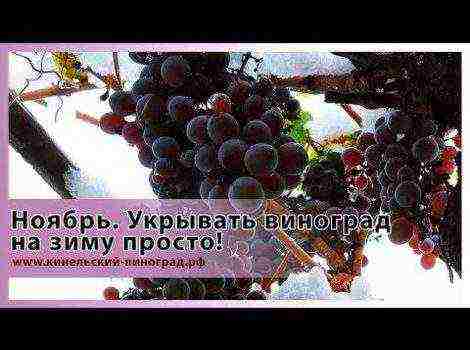Content
- 1 Sweet gooseberry varieties. The best.
- 2 White Nights
- 3 Candy
- 4 Pink 2
- 5 Seedling Lefort
- 6 Cooperator
- 7 Belarusian sugar
- 8 Russian yellow
- 9 Sirius
- 10 Beryl
- 11 Chernomor
- 12 How to choose a gooseberry variety
- 13 Review of the best gooseberry varieties
- 14 Recommended varieties for the Moscow region
- 15 Varieties for central Russia
- 16 ★ Top 7 sweetest and most delicious gooseberry varieties
- 17 🎥 Video advice from Pomoleiko Alexander Vladimirovich "Gooseberry varieties are red, green and thornless"
- 18 Gooseberry varieties for wine
- 19 Heading "Question-answer"
- 20 Description of the most popular varieties for the Moscow region and central Russia
- 21 The best large-fruited gooseberry varieties
- 22 The best winter-hardy gooseberry varieties
- 23 The best studless gooseberry varieties
Introducing the best sweet gooseberry varieties. Complete and detailed description of the best sweet gooseberry varieties.
Sweet gooseberry varieties are varieties that were selected not only for sweet, dessert taste, but these sweet gooseberry varieties should have had better winter hardiness, better resistance to major diseases and pests, and better resistance to various adverse weather conditions.
Sweet gooseberry varieties. The best.
ENGLISH YELLOW - The best sweet gooseberry variety: high yielding. European grade. Frost resistant. The bush is tall, compact. Thorny. The yield is very high (15-20 kg per bush). Berries are above average and large (4-5 g), round-oval, amber-yellow. The taste is sweet with a slight sourness, a wonderful dessert. A sweet medium-ripening gooseberry variety.
BELARUSSKIY SUKHARNY - the best sweet gooseberry variety: large. Bred at the Institute of Fruit Growing of the National Academy of Sciences of Belarus. Winter hardy. Powdery mildew resistance is average. The bush is tall, slightly spreading. The spine is average. Harvestable. The berries are large (4.1-8.5 g), round-oval, greenish-white. The taste is sweet, delicate. A sweet gooseberry variety of medium early ripening.
WHITE NIGHTS - the best sweet gooseberry of the early varieties. Bred at the Leningrad Fruit and Vegetable Experimental Station (Pavlovsk). Winter hardy. Resistant to powdery mildew and anthracnose. The bush is medium-sized, compact. The thorns are medium along the entire length of the shoot. The yield is good (5 kg per bush). The berries are medium and large (2.6-6.5 g), round, yellowish in color. The taste is sweet. A sweet variety of early ripening gooseberries.
Beryll is the best sweet gooseberry variety: large. Bred in the South Ural Research Institute of Horticulture and Potato Growing (Chelyabinsk). Winter hardy. Powdery mildew resistant. The bush is medium-sized, medium-spreading. Weakly spiked: thorns at the bottom of the shoot. The yield is high (6-9 kg per bush). The berries are large (7 g and up to 8.9 g), rounded, whitish-green. The taste is sweet. Tasting score 4.5-5 points. A sweet medium-late gooseberry variety.
VLADIL (Commander) - the best sweet gooseberry variety: no thorns. Bred in the South Ural Research Institute of Horticulture and Potato Growing (Chelyabinsk). Average winter hardiness. Highly resistant to powdery mildew. The bush is vigorous, slightly spreading. Almost without thorns. The yield is high (6-8 kg per bush). The berries are medium (2.5-4.2 g), dark red. The taste is sweet. Tasting score 4.6 points. A sweet gooseberry variety of medium early ripening.
COOPERATOR is the best sweet gooseberry variety: highly drought-resistant and heat-resistant. Bred in the South Ural Research Institute of Horticulture and Potato Growing (Chelyabinsk). Winter hardy.Powdery mildew resistant. The bush is medium-sized, medium-spreading. Weakly spiked. The yield is good (5 kg per bush). The berries are large (7 g), pear-shaped, dark red. The taste is sweet. Tasting score 4.8 points. A sweet medium-late gooseberry variety.
LADA is the best sweet gooseberry variety: large. Introduced to VSTISP (Moscow). Winter hardy: tolerates deep winter thaws well. Powdery mildew resistant. The bush is wide, semi-spreading. Medium spiked. The yield is good (5 kg per bush). The berries are large (5 g and up to 10 g), rounded, dark red. Dessert taste, sweet with moderate sourness. A sweet medium-late gooseberry variety.
PET - the best sweet gooseberry variety: tasting score 5 points. Bred in the Research Institute of Horticulture of Siberia. M.A.Lisavenko (Barnaul). Winter hardy. Weakly affected by powdery mildew and anthracnose. The bush is medium-sized, spreading. The thorns are medium, triple. The yield is good (4 kg per bush). The berries are medium (4 g), oval, yellow. Dessert taste, sweet with moderate sourness. A sweet variety of early ripening gooseberries.
HONEY - the best sweet gooseberry variety: with a honey flavor. Bred in the All-Russian Research Institute of Horticulture. I.V. Michurina (Michurinsk). Winter hardy. Relatively resistant to powdery mildew. The bush is vigorous, slightly spreading. Thorny. The yield is good (3.5-4 kg per bush). The berries are medium and large (3-6 g), round or pear-shaped, green. When fully ripe, golden. Dessert taste with honey flavor. A sweet medium-ripening gooseberry variety.
DRESS - the best sweet gooseberry variety: tasting score of dark cherry berries 5 points. Bred in the South Ural Research Institute of Horticulture and Potato Growing (Chelyabinsk). Winter hardy. Powdery mildew resistant. Slightly spiny shoots: thorns in the lower part of the shoot. Yielding (6 kg per bush). The berries are large (5.1 g), dark cherry. The taste is sweet with moderate sourness. Tasting score 5 points. A sweet medium-ripening gooseberry variety.
GENTLE - the best sweet gooseberry variety: large. Brought to VSTISP. Winter hardy. Powdery mildew resistant. The bush is tall, erect, dense. No thorns. The yield is good (5-6 kg per bush). The berries are large (5g and more), round, light green. Dessert taste, sweet with moderate sourness. A sweet variety of late-ripening gooseberries.
MEMYAT VOLUZNEV - the best sweet gooseberry variety: a very beautiful golden yellow berry + high-yielding. Bred at the Institute of Fruit Growing of the National Academy of Sciences of Belarus. Winter hardy. Powdery mildew resistant. The bush is medium-sized. Weakly spiny: light-colored thorns. The yield is high (up to 8-10 kg per bush). Berries are below medium size (3.5 g), round-oval, golden yellow. The taste is sweet, delicate. Tasting score 4.5-4.8 points. A sweet medium-ripening gooseberry variety.
SPRING - the best sweet gooseberry variety: large. Brought to VSTISP. Winter hardy. Powdery mildew resistant. Differs in high berry setting in adverse weather conditions. The bush is medium-sized, compressed. Single thorns, short at the bottom of the shoot. The yield is good (4-5 kg per bush). The berries are large (5-6 g and up to 8 g), round-oval, yellow-green. Dessert taste. High quality processed products. A sweet variety of early ripening gooseberries.
URALSKY PINK - the best sweet gooseberry variety: high-yielding, large, excellent taste, tasting rating of dark pink berries 5 points. Bred in the South Ural Research Institute of Horticulture and Potato Growing (Chelyabinsk). Winter hardy. Weakly affected by powdery mildew. The bush is medium-sized, semi-spreading. Thorny. The yield is high (up to 10 kg per bush). The berries are large (3.9-7.5 g), dark pink, almost red. The taste is sweet with a slight sourness. Tasting score 5 points.A sweet medium-late gooseberry variety.
FANTASY - the best sweet gooseberry variety: early-growing - for 2-3 years. Bred in the South Ural Research Institute of Horticulture and Potato Growing (Chelyabinsk). Winter hardy. Weakly affected by powdery mildew. Thorny. The yield is good (5.6 kg per bush). The berries are large (3.9-6.5 g), pink. The taste is sweet. Tasting score 5 points. A sweet medium-ripening gooseberry variety.
The material was prepared on the basis of the works of O. N. Aladina - a professional in the field of systematization of varieties of currants and gooseberries.
So, you are presented with all sweet gooseberry varieties. The best.
Read more articles on gooseberries.
Sweet gooseberries are especially good when fresh. They are also used to prepare jelly, jam, wine, add to sauces and use in folk medicine. Plant a bush of this kind on the site and pamper your loved ones with a healthy treat!
Gooseberry is one of the most popular berries in the gardens of many summer residents. It has been known in our latitudes since the 11th century. More than 1,500 gooseberry varieties are cultivated in the world. It is effective as a diuretic and choleretic agent, and is also rich in pectins (these substances help cleanse the body of toxins, radioactive elements and other harmful substances). The traditional taste of gooseberries is sweet and sour, but today let's talk about varieties of gooseberries with sweet berries.
White Nights
Despite the strong thorniness of the shoots and the relative small fruitiness, this gooseberry variety is loved for the sweet taste of the berries. The variety was obtained by crossing the varieties Mysovskiy 17 and Hansa. It has been registered in the State Register of Breeding Achievements since 2000.
The leaves are medium in size, the color of the berries is yellowish. A short, compact bush will not take up much space in the garden. The variety is universal, the fruits are good both fresh and for harvesting. Suitable for growing in the Northwest region.
| Ripening period | Average berry weight (g) | Productivity (kg per bush) | Peculiarities |
| Early | 3,4 | 4,4-6,2 | Winter-hardy, resistant to powdery mildew, slightly susceptible to septoria and anthracnose. |
Candy
The aroma and sweet taste of the berries confirms the name of this gooseberry variety. Plants of this variety tolerate drought well, so the hot summer will not ruin the harvest. The purpose of the variety is universal: it can be used for jam, compotes, as well as fresh.
The spine of the shoots is average, the leaves are small. The peel of the gooseberry variety Candy medium density. Suitable for growing in the West Siberian and East Siberian regions.
| Ripening period | Average berry weight (g) | Productivity (kg per bush) | Peculiarities |
| Average | 3,1 | 1,8-6,2 | Frost-resistant variety, average resistance to pests and diseases. |
Pink 2
The variety was obtained by crossing the varieties Seedling Lefor and Date. This sweet large gooseberry (berry weight can be up to 10 g) will appeal to both those who like to taste the berry "from the bush" and hostesses who prefer to make gooseberry preparations.
The skin of the fruit is dense, which allows you to transport the berry without fear of spoiling the harvested crop. The spine is not high. The variety is suitable for growing in the Central and East Siberian regions, but demanding on conditions.
| Ripening period | Average berry weight (g) | Productivity (kg per bush) | Peculiarities |
| Mid-early | 5-6 | 3-5 | High resistance to septoria, powdery mildew, anthracnose. |
WITHeian Lefort
The weak spine of the shoots, as well as consistently good yield in addition to the excellent taste of the berries - these are the advantages for which this versatile gooseberry variety is loved. The berries of the Seedling Lefora variety have a thin skin and a bright aroma.
Suitable regions for growing gooseberry varieties Seyanets Lefora: North, North-West, Volgo-Vyatsky, Uralsky, West Siberian.
| Ripening period | Average berry weight (g) | Productivity (kg per bush) | Peculiarities |
| Mid-early | 3,8 | 2,1-3,7 | Highly resistant to powdery mildew, winter-hardy. Resistance to septoria and spheroteca is average. |
Cooperator
Distinctive features of the Kooperator variety: low spine of shoots, large size and sweet dessert taste of berries. The bush is not sprawling, compact and at the same time dense. From below, almost to the middle of the bush, the shoots are covered with a pinkish bloom ("tan").
Delicious confitures, preserves, compotes are obtained from the gooseberries of this variety. The variety was included in the State Register in 1999 and is perfect for growing in the Ural region.
| Ripening period | Average berry weight (g) | Productivity (kg per bush) | Peculiarities |
| Average | 3,6-8,0 | 3,7-6,9 | Resistant to anthracnose, powdery mildew and sawfly beetle attacks. It is moderately resistant to septoria. |
Belarusian sugar
The variety, bred at the Institute of Fruit Growing of the National Academy of Sciences of Belarus, is popular among those who prefer the sweet taste of berries. The bush is compact, but rather tall. The spine of the shoots is average.
The gooseberry of this variety grows well in loamy and clayey soils, "gets along" well next to other crops, and gives a bountiful harvest for 12-18 years.
| Ripening period | Average berry weight (g) | Productivity (kg per bush) | Peculiarities |
| Average | 4,1-8,5 | 3,5-6 | Medium resistance to anthracnose and powdery mildew. |
Russian yellow
A spontaneous yellow-fruited clone of the Russkiy variety. Compared to the "relative", the berries are more delicate in taste. The spine of the shoots is weak. The bush is of medium height, compact. Ripe fruits are able to stay on the bush for a long time without cracking.
This versatile variety was included in the State Register in 1974. Suitable for growing in the North-West and Ural regions.
| Ripening period | Average berry weight (g) | Productivity (kg per bush) | Peculiarities |
| Average | 5-7 | 4,1 | Relatively resistant to powdery mildew. High winter hardiness and good transportability. |
Sirius
In spite of its small fruit size, the gooseberry of the Sirius variety fell in love with summer residents due to the delicate, sweet taste of berries. Suitable for making jam, compote, etc. It is no less tasty when fresh.
The bush is compact, straight. The Sirius variety is drought-resistant. Suitable for growing in the Central Black Earth Region.
| Ripening period | Average berry weight (g) | Productivity (kg per bush) | Peculiarities |
| Mid late | 2,7-3,5 | 4-7,3 | High frost resistance, resistance to powdery mildew. |
Beryl
This variety is the "brainchild" of the varieties Nugget and Malachite. The bush has a dense medium spreading crown, the spine of the shoots is weak. The berries are not very large, but very sweet.
The variety is universal: fruits are eaten both fresh and in the form of jams, compotes, confitures. Suitable for growing in the Ural and West Siberian regions.
| Ripening period | Average berry weight (g) | Productivity (kg per bush) | Peculiarities |
| Average | 2,8-3,4 | 3,1-9 | Winter-hardy variety, resistant to powdery mildew, but not too resistant to septoria. |
Chernomor
The berries of this gooseberry are not too large, however, Chernomor is one of the "sweetest" varieties. The spine of the shoots is weak, the bush is tall and spreading.
Used for the preparation of blanks or consumed fresh. The variety is also distinguished by drought resistance. Recommended for cultivation in the Central region.
| Ripening period | Average berry weight (g) | Productivity (kg per bush) | Peculiarities |
| Mid late | 3 | 3,1-4 | High winter hardiness. Resistant to powdery mildew, as well as moth. |
If you have already chosen the right sweet gooseberry variety for your garden, we suggest reading our material on how to plant this plant correctly:
There are many varieties of gooseberries. This culture has existed for many centuries.In order to collect a consistently high yield, you need to understand all this variety and choose the hybrid that suits you best. Consider in the article the best varieties of gooseberries, we will give recommendations on the choice and care.
How to choose a gooseberry variety
For the right choice, you need to know the features of gooseberry cultivation, otherwise in your climatic zone it may not take root or die over the winter. All its varieties have different color, taste, fruit size, ripening time. Some have thorns, others do not. It is necessary to pay attention to the susceptibility of the variety to diseases, otherwise you will later face this complex problem. It is also worth finding out how a particular variety tolerates drought.
Depending on the place of origin and general properties, the Gooseberry family can be divided into three large groups.
- European gooseberry. It is distinguished by its large fruits and rich taste. However, at the same time - a weak resistance to viruses and diseases and a very low ability to reproduce.
- American gooseberry. It is characterized by small fruits with an indefinite taste. But it is resistant to fungal diseases. Reproduction occurs by layering and cuttings.
- American-European hybrid gooseberry. It has large fruits with a pronounced taste. Relatively resistant to disease, extremely fertile.
The best varieties of this berry are quite unpretentious and at the same time high-yielding.
There are also types of gooseberries adapted for cultivation in the Moscow region, Siberia, and the Urals. They also have differences among themselves. They have different sizes of fruits, their color (green, yellow, red, purple). They have or are missing thorns. They also have different ripening times, yields.
Bushes with straight shoots, not prone to the formation of many shoots, are considered the most convenient on the farm. Such bushes grow rare, and this gives unlimited access to fresh air and sunlight. As a result, it becomes easier to care for the bushes, and the yield increases (see → ways to increase the yield of gooseberries)
Review of the best gooseberry varieties
The gooseberry has more than 160 species, which differ from each other.
When choosing, you need to focus on the climatic conditions of your region, or immediately choose resistant species, focused on growing in Siberia. You also need to take into account the taste of gooseberries, which you prefer: some people like fruits with sourness, others like sweet varieties. Least of all difficulties with thornless bushes.
Tip # 1. The bushes you choose should not be prone to forming too many shoots, or you will be forced to prune every now and then.
Read the article ⇒ pruning gooseberries in autumn
Recently, a lot of gooseberry varieties have appeared that can be successfully cultivated in a variety of climatic zones. If you want to get an excellent harvest, you need to plant the best varieties on your site.
Recommended varieties for the Moscow region
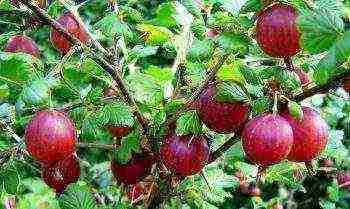
When choosing a gooseberry, you need to pay attention to the necessary conditions for its cultivation.
When choosing among the varieties of gooseberries for the Moscow region, you need to take into account the climate of this region. The yield and survival rate of this crop are greatly influenced by rather long winters and a shortage of summer heat. Experts recommend considering winter-hardy hybrids with a strong root system that can easily tolerate climate change.
- "Sirius". The berries of this medium-ripening gooseberry variety, several pieces, are collected in a brush. Small rounded fruits have a sweet and sour taste. In the conditions of the Moscow region, the variety normally survives the cold. Not susceptible to fungal diseases and pests.
- "Grushenka". The fruits are pear-shaped. Single thorns. Berries are collected in a brush in a couple of pieces. When ripe, they acquire a rich dark color. Delicious. Virtually no seeds.The berries contain a large amount of pectin.
- Uralsky. Fast growing bushes of this gooseberry variety are grown on supports. Berries "Uralsky" are large, sweet with sourness. The variety is resistant to powdery mildew. It is practically not touched by pests. High-yielding.
- "Northern Captain". The dark berries of this variety are not very tasty to eat raw. However, gardeners willingly grow it to make good wine. The variety is high-yielding, frost-resistant. Has resistance to disease.
- "Belarusian Sugar". This is an early ripening variety. Compact, small, low bushes. On the shoots there are oblong, very sharp spines. The variety is cold-resistant, disease-resistant, undemanding to growing conditions. Large green berries, very sweet. The mass of one berry is more than 9 grams. They are good for making jams, compotes, fresh consumption.
- "Malachite". The variety is very popular. It features a tall, spreading bush grown on a support. Shoots are practically thornless. Green berries weigh about 6 grams. High-yielding. In the conditions of the Moscow region, it tolerates cold weather well. Disease resistant.
- "Kolobok". For the Moscow region, this is one of the best varieties. Tall bushes grow quickly. It has small thin spines. Differs in a very good yield. Round large berries weigh 8-9 grams. They have juicy dark cherry pulp with excellent taste. "Kolobok" is resistant to fungal diseases and temperature changes. Constant pruning of bushes increases productivity. Read also the article: → "Cutting trees and shrubs."
- "Krasnoslavyansky". Differs in medium-sized compact bushes. Sharp thorns are located along the entire length of the shoots. The berries have a very good dessert taste with a slight sourness. If the variety is well looked after, it tolerates cold normally. His bushes need to be sprayed against fungal diseases.
- "Russian yellow". Has established itself as cold-resistant and fruitful. Spreading bushes, medium-sized. Shoots practically do not have thorns. Sweet berries of a pleasant amber color can hang on the bush for a long time without falling off.
- "Spring". It is considered one of the best gooseberry varieties. Its distinctive qualities are stable yield, excellent fruits, good winter hardiness, and disease resistance. Bushes are medium in size. Shoots with short thorns at the base of the bush. Large oval yellowish-green berries with a red barrel have excellent taste, which is why the variety is so popular among gardeners.
Varieties for central Russia
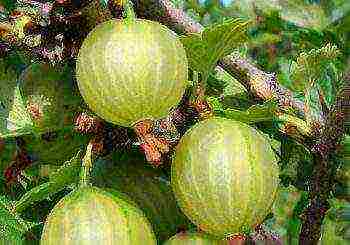
Basically, most varieties are great for the climate of Russia and the Moscow region
Usually these varieties are winter-hardy, high-yielding. Resistant to diseases such as moth, powdery mildew.
- "Seedling of the Spring". The variety has a medium-early ripening period. Yellowish-green berries weighing 4-6 grams have a dessert taste. Resistant to spring frosts and temperature extremes. Enters fruiting early. The variety is valuable for its high yield - up to 9 kilograms per bush.
- "Golden Light". Medium ripening variety. Drought-resistant and winter-hardy. The amber-yellow berries have a sweet and sour taste. Possesses "Golden Light" of great resistance to diseases.
- "Masheka". A variety of medium ripening. It is considered universal. Winter-hardy. Resistant to diseases and pests. The bush is compact, vigorous. Shoots are light-colored, slightly spiny. The mass of round-oval berries is 3-4 grams.
- "Rawolt". It is called fruitful, winter-hardy, self-fertile. Shoots have a few thorns. Medium-sized dark red juicy berries weigh 4-5 grams.
- English yellow. The bush is upright, compressed. Oval, medium-sized amber berries weigh 4-8 grams. Very sweet and delicious. You can collect up to 21 kilograms of berries from a bush. Winter-hardy. Spheoteka is weakly affected.
- "Seedling of Lefort". Possesses high winter hardiness. Relatively resistant to powdery mildew.For the middle lane, it is considered one of the best, since it is harvested: 6-10 kilograms of berries are removed from the bush. The bush is sprawling, powerful, thin, drooping shoots have thorns of medium thickness. Red-purple round-oval small berries have a delicate aroma and dessert taste.
- Olavi. The berries are medium in size, weighing 3.7 grams, are oval, dark cherry, with a thin skin. Juicy, sweet and sour taste, almost no aroma.
- "Chernomor". It is a weakly spreading, vigorous bush with a dense crown. Shoots are slightly prickly. Berries of medium size, oval, dark red, almost black, without pubescence, with an average number of seeds. They have a harmonious sweet and sour taste.
★ Top 7 sweetest and most delicious gooseberry varieties
When choosing a variety, pay attention also to the color of the fruit and to the shape.
| Variety name | Characteristic |
| "Beryl" | Fruits are large, up to 9 g, light green, round, sweet and sour. Thorns at the base of the branches. Winter hardy. Productivity 3-10 kg per bush. Unstable to septoria. No pollinators required. |
| "Candy" | With spikes. Pink fruits weigh 3-6 g. Fragrant, sweet and sour. Winter hardy. Pollinators are not required. Harvest 1.8-6.2 kg per bush. Resistant to powdery mildew and anthracnose. Unstable to septoria. |
| "Cooperator" | With thorns at the bottom of the shoots. Berries weight 3.6-8.0 g. Dark cherry, thin-skinned, sweet and sour. The variety is winter-hardy. Yield: from a bush - 3.7-6.9 kg. No pollinators are needed. Resistant to powdery mildew, anthroknose, sawflies. Unstable to septoria. |
| "Krasnoslavyansky" | The variety is very prickly, with thorns along the entire length of the shoots. Dark cherry berries weigh 3.9-6.0. The skin is thin. The taste is sweet. Productivity - up to 6 kg per bush. It is not resistant to powdery mildew. |
| "Pink 2" | A few spines grow along the entire length of the shoots. Pink-red sweet and sour large berries weigh 5-6 g. Productivity 5 kg per bush. No pollinators are needed. Resistant to disease. But it requires fertile soil. Read also the article: → "Fertilizing the soil with manure." |
| "Ural Emerald" | Average number of thorns along the entire length of the shoots. The berries are large, weighing 3.5-7.5 g. Green, thin-skinned, sweet. Productivity per bush 2.1-5.6 kg. Winter-hardy variety. Disease resistant. |
| "Ural pink" | Long spines in the middle of the shoots. Berries weight 3.7-6.4 g. Color is bright pink with orange tint. Productivity up to 10 kg per bush. Winter-hardy. Disease resistant. |
🎥 Video advice from Pomoleiko Alexander Vladimirovich "Gooseberry varieties are red, green and thornless"
A recommendation from Pomoleiko Alxandra (owner of a farm) on the choice of gooseberry varieties for the garden ⇓.
Gooseberry varieties for wine
One of the first places among the berries in winemaking is the gooseberry. Sometimes gooseberries are called "northern grapes". And for good reason. Its fruits even look somewhat like grapes. And in taste and aroma, wine made from it is similar to grape wine and is considered the best in taste among fruit and berry wines. Almost all gooseberry varieties are suitable for winemaking. But the most delicious is still obtained from varieties with large red or yellow berries.
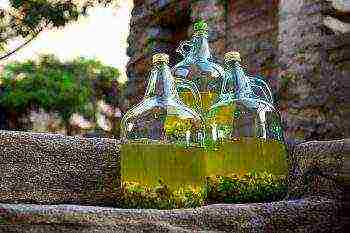
You can make dry, table, sweet and dessert wines from gooseberries. It can have a different color and a subtle bouquet of aroma.
It is relatively easy to prepare gooseberry dessert wine at home. For this, a liter of pure juice is diluted with the same amount of water and 350 grams of sugar is added. And then the intoxicated drink is prepared according to the usual technology. It will become soft and harmonious in taste in at least six months. From gooseberries, you can get any kind of wine and excellent quality, especially if it is well aged. The best gooseberry wines are considered to be dessert and strong wines with a bouquet and taste reminiscent of sherry.
To make your gooseberry wine of high quality, you need to listen to some advice from winemakers:
- Use ripe or unripe berries to make wine.Overripe gooseberries lose their aroma and taste, and the wine turns out to be cloudy.
- The berries are processed immediately after harvest. After lying down for a while, they will lose their aroma.
- Berries for wine must be carefully sorted out, so that there are no spoiled specimens among them.
- To obtain a more aromatic wine after crushing the berries, the resulting pulp should stand for 2-3 days in a cool place. And only after that it can be pressed.
- Table wines made from highly diluted gooseberry juice can produce an unpleasant odor. Therefore, dilute the juice with water equally (50:50). Water can be replaced with non-acidic apples or pears. It is not without reason that gooseberry table wines are usually prepared with the addition of white currants or other berries.
- Depending on the color of the berries, wines are obtained in different shades: dark yellow, golden yellow, greenish yellow.
- Gooseberry table wines have a rather pungent taste and characteristic flavor that are absent in sweet and strong gooseberry wines.
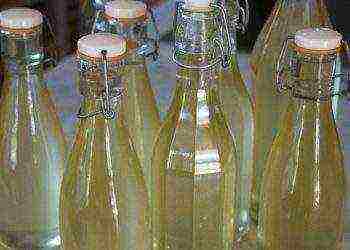
Winemakers and tasters rate gooseberry wines very highly - they are given 9 points on a 10-point scale. Gooseberry wine is especially popular in France.
For the preparation of dry and semi-sweet wines, the following varieties are used:
- "Russian",
- "Kazachok"
- "Weakly spiked".
For dessert wines:
- "Chernomor",
- "Anniversary",
- "Plum",
- "Prune" features of cultivation and care.
Heading "Question-answer"
Question number 1. When and how to plant gooseberries?
To plant gooseberries, buy 2 year old bushes or strong 2 year old cuttings. In this case, pay special attention to the roots, which should be no shorter than 20 centimeters. The bushes must have 2-3 strong shoots, the length of which is at least 30 centimeters and several buds.
Tip # 2. Many gardeners believe that autumn planting is much more effective. The best period for this is the end of September and the first decade of October.
Question number 2. Can bushes be planted both in spring and autumn?
Before the onset of cold weather, the root system manages to get stronger, take root, so in the spring the bush begins to grow and develop rapidly. And with the spring planting, the main thing is not to be late. You need to plant the plant while it is dormant. Read also the article: → "September chores, or what is planted in September at the dacha?" Gooseberry buds bloom very early, so planting should be done before early April. However, remember: after planting in spring, the plant takes root much worse.
Rate the quality of the article. We want to be better for you:
Gooseberries can be found in almost every site in the central region of Russia. Gardeners often think about which variety to choose and plant. Let's try to figure it out together by reading the description of the most popular ones. Varieties are divided according to many criteria, Kolobok, Grushenka, Russian yellow and Amber are most suitable for the Moscow region... The most frost-resistant are Beryl, Ural emerald, Consul and others. The largest fruits are produced by the varieties Zashchitnik, Kooperator, Leningradets and others. They have excellent taste - Medovy, Kaptivator, Pushkin, Sadko, Laskovy, English, Mashenka and others. Thornless gooseberries are the safest, besides, it is easier to care for them, the best and most popular varieties are Eaglet, African, Thornless gooseberry and others.
Description of the most popular varieties for the Moscow region and central Russia
Grushenka
 Gooseberry variety Grushenka
Gooseberry variety Grushenka
Medium-sized shrub with drooping branches. There are practically no thorns on the shoots. The berries are medium-sized, on average they weigh 5 grams, the shape is pear-shaped, and the color changes as the fruits ripen (from pale red to deep purple). The variety is perfect for growing in central Russia, it is able to easily endure frosts, winter cold and drought. It is immune to many diseases.
Russian yellow
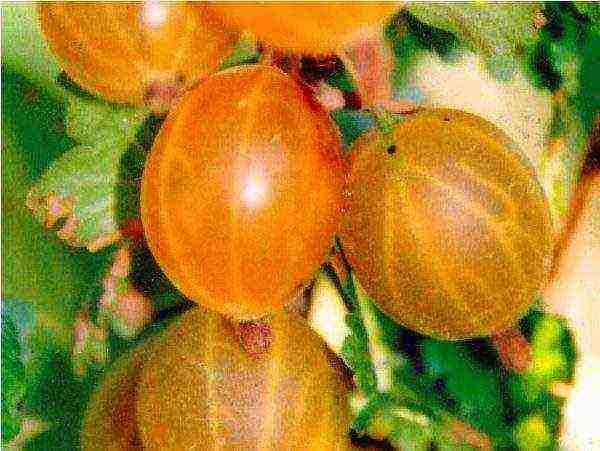 Gooseberry variety Russian yellow
Gooseberry variety Russian yellow
A low bush with medium spreading, covered with thorns throughout the area. Produces yellow pear-shaped fruits weighing up to 6 grams... The presence of a thin waxy coating is characteristic. The variety is distinguished by its excellent tolerance to sudden changes in temperature, frost and drought. Self-fertile, not affected by many common diseases.
Amber
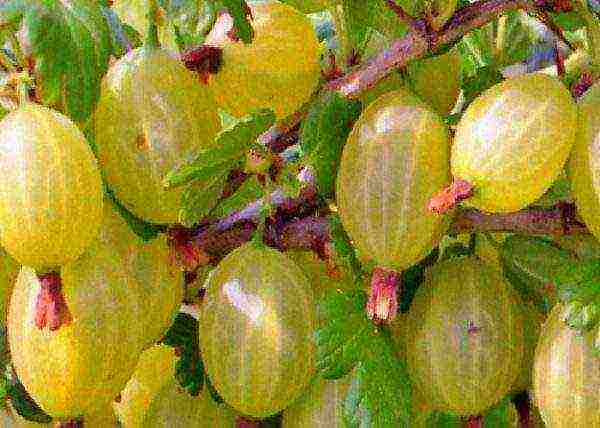 Gooseberry grade Amber
Gooseberry grade Amber
A tall shrub can grow up to 1.5 meters. The crown is dense and spreading, and there are also many thorny thorns on it. But all these disadvantages are compensated by delicious and beautiful fruits. Berries are yellow-orange in color and oblong in shape, on average, weigh 5-6 grams... Amber gooseberries are early varieties and have a very high yield. Also, this shrub tolerates frost and drought well.
Gingerbread man
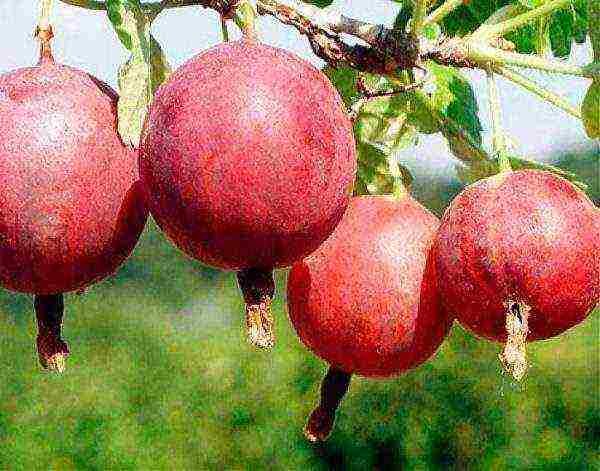 Gooseberry variety Kolobok
Gooseberry variety Kolobok
A medium-sized shrub with thorns, which are located singly, most often on the lower part of the branches. Fruits are large in size, their weight reaches 7 grams... The shape of the berries is slightly elongated, the color is pale red. The taste is pleasant, sweet and sour. The variety tolerates frost well, is resistant to anthracnose and powdery mildew.
The best large-fruited gooseberry varieties
Defender
 Gooseberry variety Defender
Gooseberry variety Defender
A tall shrub with powerful branches and a straight crown. The mass of berries can reach 10 grams, their shape is oval-pear-shaped, the color is burgundy, almost black... The taste of the fruit is sweet and sour. Refers to varieties with a late ripening period. The defender tolerates frost well, does not undergo powdery mildew.
Cooperator
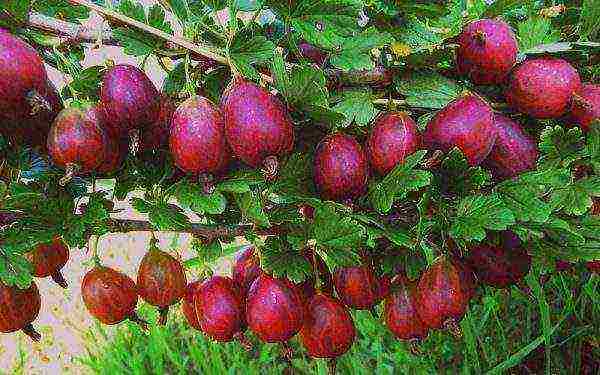 Gooseberry variety Cooperator
Gooseberry variety Cooperator
This type of shrub has a medium height and a sparse, slightly spreading crown with a small number of thorns. On average, one berry weighs 7 grams, pear-shaped, dark red color... Such fruits are considered dessert, they are very tasty and sweet. Up to 5 kilograms of harvest can be harvested from one bush, the ripening period is medium late. Another advantage of the variety is its resistance to cold weather and fruit rot.
Leningrader
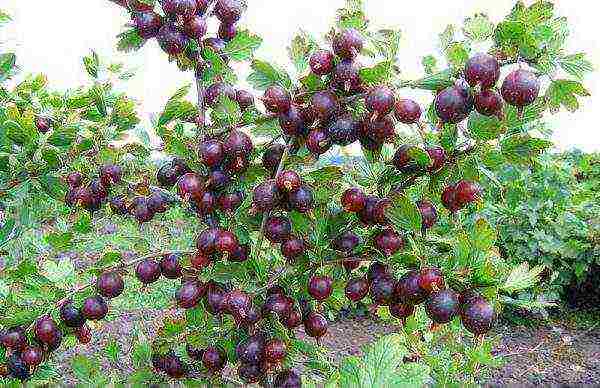 Gooseberry grade Leningradets
Gooseberry grade Leningradets
A bush of medium height with a semi-spreading crown, thorns are practically absent. The berries are large, their weight can reach 10 grams, the shape resembles an inverted egg, the color is dark red... Gooseberry taste sweet and sour. From one bush, you can collect up to 7.5 kilograms of harvest, medium late ripening. The shrub is winter-hardy, moderately exposed to powdery mildew.
Spring
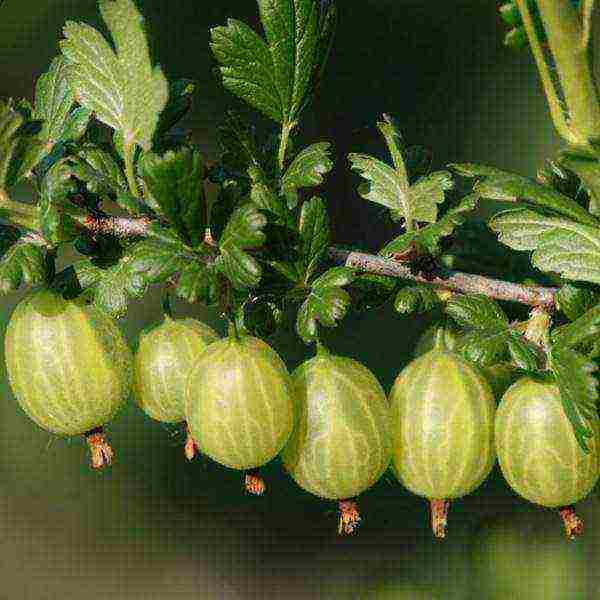 Gooseberry variety Rodnik
Gooseberry variety Rodnik
Shrub of medium height with a compact, neat crown. On average, the fruits weigh 5-6 grams, but their weight can reach 8 grams, the shape is round-oval, the color is dull, yellow-green... The taste of such berries is very pleasant, sweet, they are suitable both for fresh consumption and for any kind of processing. The variety is resistant to frost and fungal diseases, it is distinguished by its ability to reproduce crops even under unfavorable climatic conditions.
The best winter-hardy gooseberry varieties
Beryl
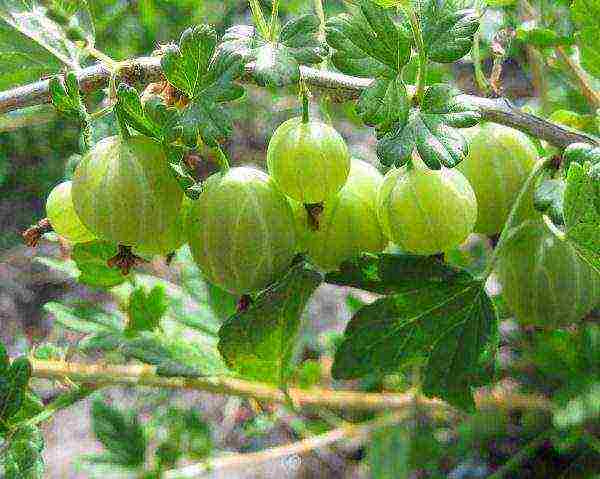 Gooseberry Beryl grade
Gooseberry Beryl grade
Medium-sized shrub with a neat crown. Thorns are present at the bottom of the shoot. The weight of the berries can reach 8-9 grams, the shape is spherical, the color is light green... The taste of the fruit is dessert, highly appreciated by professional tasters. One bush brings up to 9 kilograms of harvest and can survive frost down to -36 degrees. Also, the variety is resistant to fruit rot.
Ural emerald
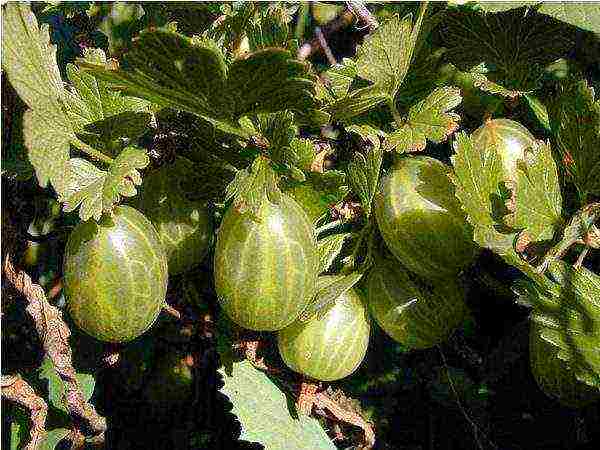 Gooseberry grade Ural emerald
Gooseberry grade Ural emerald
Medium-sized shrub with few thorns on the shoots. Berries are distinguished by the absence of pubescence, their weight can reach 8 grams... This variety got its name due to the bright color of the fruit with a dessert taste and pleasant aroma. The first harvest can be obtained at 3-4 years of age, the ripening period is medium early. Frost resistance is high, such a shrub can withstand cold temperatures down to -37 degrees.
Consul
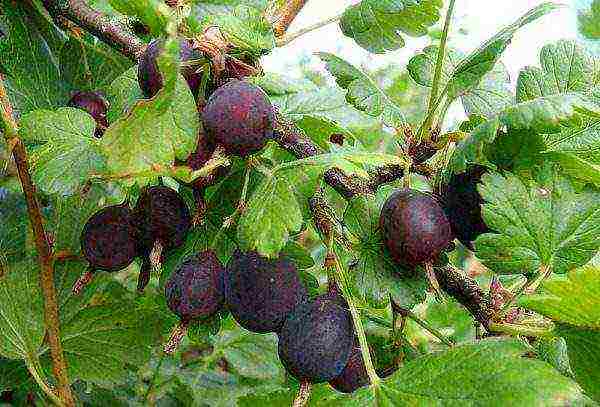 Gooseberry grade Consul
Gooseberry grade Consul
Another name for this variety is senator. A medium-sized bush with a dense crown, on which thorns are practically absent. The berries are large, their weight can reach 6 grams, the color is maroon, almost black... The skin of the fruit is very thin, so they do not tolerate transportation well. Also, such berries have very few seeds, which makes them an excellent jam. The shrub tolerates frosts well down to -37 degrees. In the first years of his life, the Senator gives little harvest, but over time this figure increases 2-3 times.
Belorussian
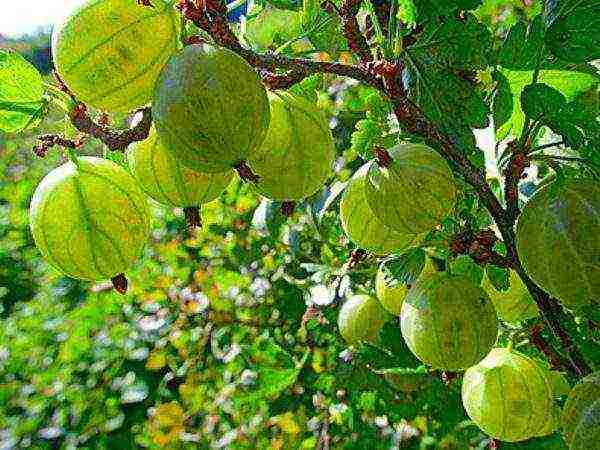 Gooseberry grade Belarusian
Gooseberry grade Belarusian
A small bush with a compact crown, on which there are a lot of sharp thorns. Ball-shaped berries weigh no more than 8 grams... The color is bright green. The taste is very pleasant, sweet, the skin of the fruit is thin, and the pulp is juicy and tender. The variety belongs to the old selection, has a very high frost resistance (up to -39 degrees). The harvest ripens in medium terms.
Krasnoslavyansky
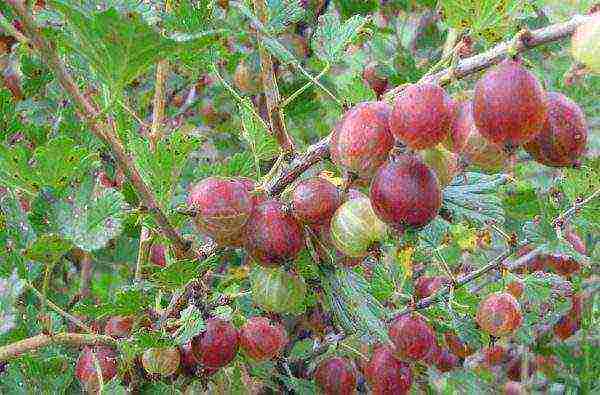 Gooseberry grade Krasnoslavyansky
Gooseberry grade Krasnoslavyansky
The bush is of medium height, slightly spreading, the crown is sparse, there are thorns on the shoots. The berries are large enough, the maximum weight can reach 9 grams, the shape is round, the color is deep red... There is practically no pubescence on the skin. The taste of such gooseberries is considered dessert. The first crop can be harvested already in the second year of the plant's life, but over time this figure becomes larger and reaches 6-7 kilograms. Also, the variety is very frost-resistant, resistant to powdery mildew.
The best studless gooseberry varieties
Eaglet
 Gooseberry grade Eaglet
Gooseberry grade Eaglet
A medium-sized shrub with a neat and small crown. The lack of thorns makes this variety one of the most popular among gardeners. On average, one berry weighs 4-6 grams, the color is almost black... Differs in the presence of a light military raid and a pleasant sweet and sour taste. The crop ripens early, the shrub bears fruit annually and abundantly, it is resistant to frost and fruit rot.
African
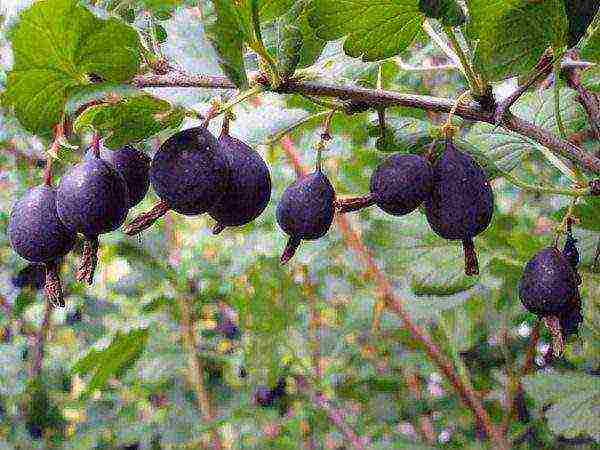 Gooseberry variety African
Gooseberry variety African
A medium-sized bush with no thorns. The berries are not large, rounded, dark purple in color... The taste of the fruit is sweet and sour, with light notes of black currant. The shrub begins to bear fruit in 2-3 years after planting, has good winter hardiness and resistance to many diseases. There is a risk of anthracnose contamination.
Northern captain
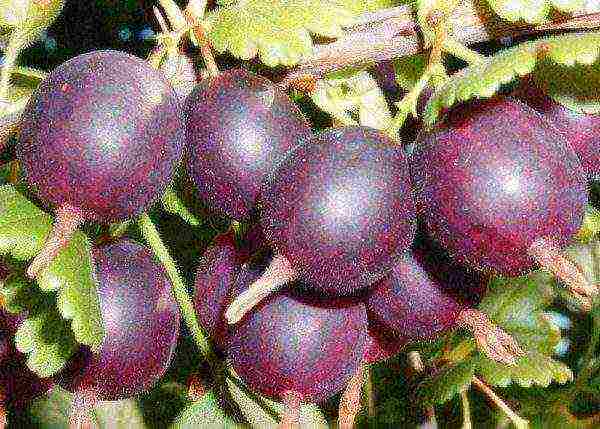 Gooseberry variety Northern Captain
Gooseberry variety Northern Captain
One of the most popular gooseberry varieties. A tall shrub with a narrow, neat crown, the branches of which grow straight up. Berries are dark, almost black in color, their weight can reach 4 grams... The taste of the fruit is pleasant, with a slight sourness. The ripening period of the crop is average. With proper care, up to 12 kilograms of fruit can be removed from one shrub... Among other things, the North Captain tolerates frost, drought well and is not exposed to many diseases.
Ural besshorny
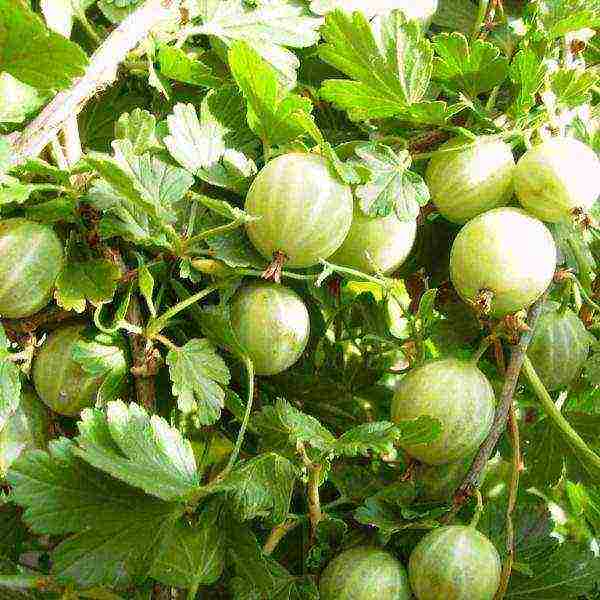 Gooseberry grade Ural Besshipny
Gooseberry grade Ural Besshipny
Medium-sized shrub that bears bright green, large (up to 8 grams) oval fruits... The variety is medium late, there is no pubescence on the skin, the fruit pulp is sweet and pleasant to the taste. The variety tolerates frost well, but may begin to drop berries ahead of time, which will lead to a loss of yield. Gooseberries are recommended to be picked a little earlier than they are fully ripe. In addition, the absence of thorns will make this process even easier and more enjoyable.
Thornless gooseberry
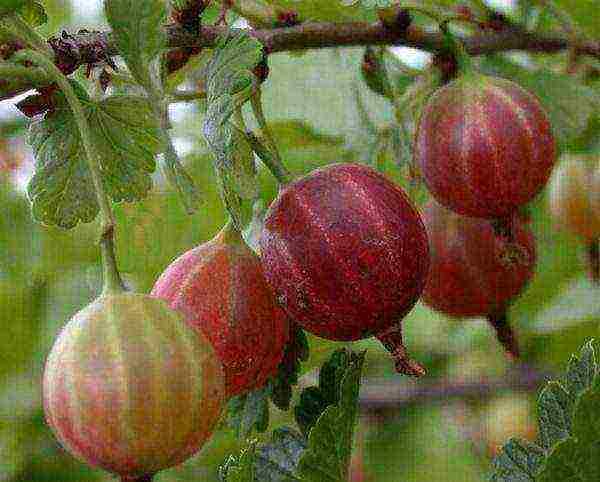 Thornless gooseberry
Thornless gooseberry
The bush is vigorous, but at the same time its crown is very compact, and the branches grow mainly upward. On average, the berries weigh 5 grams, have a drop-like shape and a light red color.... The taste of the fruit is pleasant, sweet with a barely noticeable sourness. The variety tolerates winter cold well and does not undergo powdery mildew.
Both adults and children love gooseberries. A resident of any region will be able to choose a variety suitable for himself, you can also pick berries according to taste, size and other indicators... The modern market offers a huge variety of different varieties of gooseberries.
